For many travelers, tolls in Italy are an important topic because almost all highways require a fee. Knowing how the highway toll system works can help you avoid stress during your trip. The Telepass is a convenient alternative to the classic toll ticket, allowing drivers to pay their tolls electronically.
How the Italian Toll System Works
Ticket System
This system is used on most Italian highways. When you get on the highway, you pull a ticket from a machine. The fee is calculated based on the distance you traveled when you exit.
- Payment Methods: You can pay with cash, a credit card, or an electronic toll device like a Telepass.
- Costs: Fees vary depending on the type of vehicle. Some highways are more expensive than others. For a standard vehicle, you should expect to pay around €10 per 100 kilometers (about $11 per 62 miles).
Free-Flow System
This system is used on some highways in northern Italy. On Free-Flow highways, vehicle license plates are registered without the vehicle having to stop.
- Payment Methods: You can pay with an electronic toll device or online within 15 days of using the highway at pedemontana.com.
Telepass in Italy: Is It Worth It?
The Telepass is an electronic device you mount on your windshield. It allows you to automatically pay tolls using special lanes without stopping. On Italian highways, devices from providers like
The devices from the following providers work on Italian highways: Telepass, UnipolMove and Tolltickets. For commercial transportation, devices from AS24, Axxess and DKV Box also work.
Important Note About Telepass Lanes
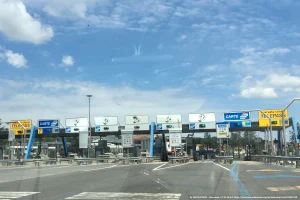
The yellow-marked Telepass lanes on highways can only be used by vehicles with an active toll device installed. If you enter a Telepass lane without a device, you risk
- delays because the gate won’t open,
- fines for improper use, and
- unnecessary stress at the toll booth.
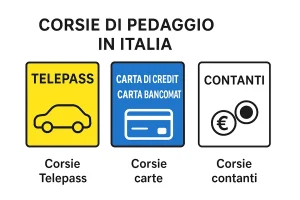
All other drivers should use the lanes with symbols for cash (coins/bills) or credit cards.
Benefits of the Telepass toll device
- No need to stop, as payments are automatically debited.
- Faster traffic flow at toll booths.
- Ideal for frequent drivers, commuters, and long road trips.
Tourists can often rent a Telepass from their car rental company or special service providers.
Free-Flow System in Italy: Tolls Without Gates
Italy has been introducing the modern Free-Flow System on certain highway sections for several years. Unlike the classic toll system, there are no gates or toll stations.
How the Free-Flow System Works
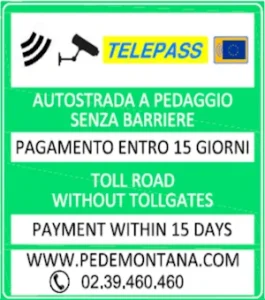
- Cameras and sensors automatically capture the license plate of each vehicle.
- The distance traveled is registered, and the toll fee is calculated afterward.
The goal of this system is to ensure smooth traffic flow without backups at toll stations.
Important Notes
- If you don’t have a toll device, you must pay within 15 days via the website pedemontana.com or at an authorized payment office.
- Unpaid tolls will result in penalties and fines.
- Tourists should check their license plate online right after their trip to avoid missing the payment deadline.
“Tutor” Highway Speed Control in Italy
Italy uses a strict system for monitoring highway speeds called the “Tutor”. This isn’t a typical speed camera that measures speed at a single point; it’s a section control system.
- How it Works: Cameras at two points on a highway section record your license plate. Your average speed is calculated based on the time it takes you to travel that distance.
- Safety Benefit: This system prevents drivers from abruptly braking only at known camera locations, as speed is monitored over several kilometers.
- Penalties: If you exceed the speed limit, you will automatically receive a fine.
- Signs are posted before sections with “Tutor” control. These devices are installed on many highways and significantly help reduce serious accidents.
In addition to the “Tutor”, stationary Autovelox cameras and mobile police controls are also used. You should always adhere to the posted speed limit, which is 130 km/h (about 81 mph) or 110 km/h (about 68 mph) when it’s raining.
Tips for Driving on Italian Highways
- Check the approximate costs beforehand using a toll calculator (for example, on the official website autostrade.it).
- Almost all highways are toll roads, and exceptions are rare.
- Always pay attention to the speed limits, especially on busy highways where the “Tutor” system is active.
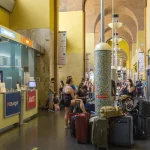
Car Rental in Italy – Everything You Need to Know
A rental car is the ideal way to discover Italy in a flexible and independent manner. Whether it’s picturesque coastal…>>>
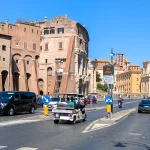
ZTL Italy · Driving Bans in Rome, Florence, Bologna & Milan
If you travel through Italy by car, you will quickly encounter the so-called ZTL zones (Zona a Traffico Limitato). These…>>>
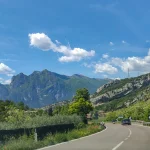
Driving in Italy – Rules, Tips & What Visitors Need to Know
Italy is a wonderful country to explore by car. From the Alps to the Adriatic coast and through picturesque old…>>>
